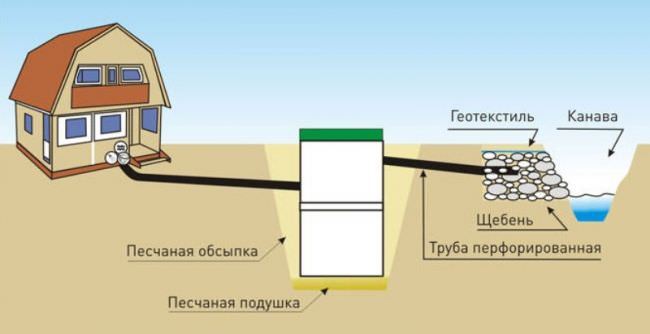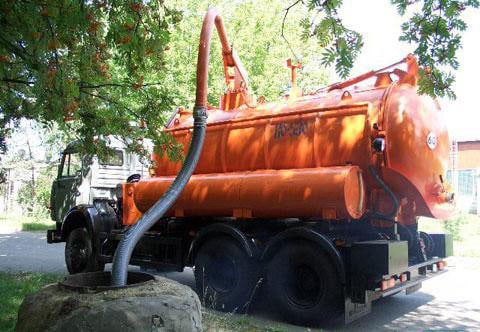How often should a septic tank be pumped out?
The use of a septic tank is considered the best solution for arranging an autonomous sewerage system in a country house. Such a treatment plant can easily cope with the collection and processing of solid waste. At the same time, insoluble compounds gradually accumulate in the sump, which from time to time have to be removed.
Independent disposal of liquid waste is used quite rarely, given the complexity and danger of this event, as well as the need to dispose of pumped out effluents. Therefore, in this situation, it is more advisable to use the services of professional vacuum cleaners. On average, a car is called 1-2 times a year. In this case, the frequency of pumping depends on factors such as:
- volume and model of the septic tank;
- the number of permanent residents;
- intensity of sewer operation;
- composition of household waste.
Pumping out the septic tank must be done in a timely manner, preventing overflow of the tank
How to arrange a filter field
The parameters for arranging the filtration field should be determined depending on the type of soil and how suitable it is for self-cleaning. The sequence for arranging a filtration field for a septic tank will be as follows:
- Dig a trench and fill the bottom with clean sand. The layer thickness should be approximately 10 cm.
- From above, a layer of crushed stone with a fraction of 20-40 mm should be poured on top of the arranged sand pillow. The crushed stone layer should have a thickness of about 35 cm.
- Now a drain is laid on the crushed stone layer and again it is covered with crushed stone from above. Geotextiles are laid on top of a layer of crushed stone 10 cm thick - this will protect the system from silting.
- After that, the trench is covered with a layer of soil.
Filtration field in the drainage system for a septic tank
Installation of a pipe for pumping water from a septic tank
In order not to depend on the length of the sewage hose, a pipeline is laid from the treatment plant, which allows the removal of effluents. In this case, the pipe for pumping out of the septic tank must correspond to a certain type and technical parameters.
Why you can not use pipes for internal sewage
In the process of pumping liquid, a negative pressure or, in other words, a vacuum is created inside the pipe. At high vacuum, the pipeline tends to compress, and in this situation the reliability of the system will depend on the strength of the material used and its suitability for work in such conditions.
Conventional gray sewer pipes that are used for indoor installation have a wall thickness of 2.2 mm, which is insufficient for operation under pressure or vacuum. Therefore, such a pipeline is used exclusively for non-pressure systems.
So what kind of pipe is needed for pumping out a septic tank? For such purposes, special pressure pipes with increased wall thickness or an orange PVC pipeline, which is intended for outdoor placement, should be used.
Orange pipes have a multilayer structure, which increases their strength and reduces thermal conductivity.
The correct diameter of the pipe for pumping liquid waste
The diameter of the pipeline must match the size of the suction hose. Theoretically, the size of the pipe for pumping water from a septic tank can be smaller. However, it should be borne in mind that in this case the pump will need more effort to create the necessary pressure, and it will work with an increased load.
Since the suction machine hose diameter is usually 100-104mm, it is preferable to use 110mm PVC pipe. The annular space can be closed with a wet rag or an adapter can be used to tightly connect the pipeline and hose.
Mounting technology ↑
Pipe laying must be carried out taking into account the following rules:
- The pipeline is laid at a shallow depth from the septic tank to the roadway. The slope is towards the septic tank.
- The pipe cuts into the septic tank at a depth of about 1 m and, with the help of a corner, turns down, resting with an oblique cut (45 °) against the bottom.
- The exit to the street is realized using a 90 ° corner, which is located in a small pit near the proposed entrance of the sewer truck.
A pit with a pipe for pumping out a septic tank is usually located near the road.
Such a system will allow the removal of liquid waste even with a significant distance from the septic tank from the roadway. In this case, the pipeline does not need to be buried below the freezing level of the soil. Firstly, it is filled with liquid only during the pumping process, and secondly, pipes for external sewerage calmly endure low temperatures.
This article provides general recommendations for the installation of a pipe for the removal of liquid effluents. If there are specific conditions for the operation of an autonomous sewage system, it is better to additionally consult with specialists.
Septic outlet pipe
The removal of treated wastewater from the septic tank occurs in 2 ways, of course, some craftsmen also have a 3rd one - through the lid, but we will consider the correct methods:
- gravity overflow from a septic tank to a drainage well
- forced drainage of water by a forced pump to the ground
With gravity flow, almost everything is done in the same way as with the supply pipe, slopes, angles can be made 90 degrees, since there is technical water at the outlet and it is easier for it to run through the pipe with any angles, but with the right slope. Warming is also not necessary, but it will never be superfluous.
Forced discharge of treated wastewater is carried out through a pipe of small diameter (25-32 mm). Pipe material can be low pressure polyethylene, polypropylene.
With a small distance of up to 2-3 m, you can make a counter slope of the pipe so that after the pump has pumped out the water, the remaining water flows back into the septic tank. In this case, it is possible to insulate only with pipe insulation (energoflex, tilit).
If the distance of the outlet pipe from the septic tank to the drain point is large, or if you doubt the observance of the counter-slope, it is best to lay the heating cable and turn it on in sub-zero temperatures. Our recommendation is to install a heating cable for any length of the outlet pipe, and it is better not to turn it on if not required, but to turn it on if necessary, if any.
One of the conditions for the proper operation of an autonomous sewer system is pumping out a septic tank. To this end, the owners of private plots periodically use the services of sewers, who, using a special machine, remove liquid household waste. If it is not possible to provide a convenient access for the machine to the treatment plant, an additional pipe is installed for pumping out the septic tank, which allows the intake of dirty water at a considerable distance.
drainage tunnels
Drainage tunnels or blocks are already a newer and more modern system, which is designed for cottages and recreation areas with a larger format. The thing is that for this replacement, the filtering fields no longer need a separate place with mandatory requirements.
Due to the characteristics of the prefabricated system, over the drainage tunnels, you can even install a gazebo, a parking lot in the country, deploy an original landscape structure, the same rockery.
But it’s worth noting right away that along with the advantages of the system in terms of work quality, strength and durability, its cost should also be immediately considered. It seems average and acceptable, but for many it can also be a serious cut from the budget.
Therefore, when studying the possibility of installing filtration tunnels in the country, immediately pay attention to the price.

Advantages of the drainage tunnel system
- We can say that this is a fairly durable system that is installed once and for many years.
- The overall design has increased strength, due to which the territory on top of the system can be used to good use.
- Truly improved performance so you don't have to worry about the number of resets.
Drainage tunnels for a country septic tank: installation recommendations
Few have worked with drainage tunnels, as this system is not suitable for everyone in terms of costs. More often, drainage wells or even just cesspools are installed instead of a septic tank. But if you want to install just such a system on the site, then we will give you some tips:
- It is highly desirable to install drainage tunnels to a greater depth. Often this happens as follows - a trench is dug with dimensions for the module, plus 40-50 cm on each side. The depth of the pit is about 2 m. 50 cm of sand are laid on its bottom, then 30 cm of rubble, and only then the module is installed, preferably on an already compacted surface.
- The modules are installed on a finished pillow and connected both to each other and to the leads from the septic tank.
- To prevent perforation from silting up, the modules are covered with geotextiles.
- Further, the system is sprinkled with rubble, and ventilation outlets are installed in special holes.
- It remains only to add a layer to the level of the soil. This is done with a mixture of earth and sand. Also, in many cases, in order to make the surface exploitable, a geogrid is laid, which we discussed in several articles on the site.
We would like to note the fact that this information is general and may partially change when choosing a particular system, as well as in combination with a septic tank installed in the country. It is highly desirable to consult on the choice of drainage for a septic tank and with specialists at the place of purchase of VOCs, because each treatment plant has its own characteristics.
Drainage for a septic tank with their own hands can be done by almost each of us, one has only to approach the issue seriously and with all responsibility. And we can only wish you success in your work and invite you to share your opinion about the material in the comments column.
http://dachadecor.ru
How wastewater is filtered
When entering the sewer, wastewater passes through the following stages of filtration:
- First, the effluents that have entered the septic facility must be settled in the first compartment. It is equipped with a special membrane protection, its task is to prevent foam and gases from entering;
- Having cleared, the liquid under pressure following the first drains passes into the next compartment, where the impurities will be split under the influence of special means. After reacting with chemical agents, impurities turn into suspensions;
- The suspension in the final compartment of the septic tank will precipitate, and the resulting liquid after cleaning passes into the distribution tank, from which it enters the drainage channels.
The minimum distance from sources of clean water must be strictly observed.
Anaerobic bacteria play a special role in the process of wastewater treatment. They get inside the septic tank when using special chemicals and help to ensure a good level of purification. These bacteria also perform another function - protective, with their help, the system is not in danger of silting.
But the septic tank is not always able to completely break down all impurities - in this case, they remain inside and, gradually accumulating, reduce work efficiency. In order to clean the septic tank as it gets dirty, it should be equipped with a special hatch through which, with the help of a sewage machine, the remnants of impurities that settle inside will be removed.
In advance, care must be taken that the vacuum trucks can freely drive up to the septic tank to clean it. To do this, before installing the septic tank and drainage system, it is necessary to draw up a plan that will indicate the location of the septic tank and possible access routes.
To provide a septic tank with the possibility of uninterrupted service, it is necessary to minimize the penetration of harmful and toxic impurities, insoluble additives into it. They may not have the best effect on the operation of the septic tank and greatly reduce its service life.
I hope that the material presented in this article helped you answer the question of how to properly make drainage for a septic tank. Happy building!
Lead pipe to septic tank
Household sewage flows from the house to the septic tank through the supply pipe into the septic tank. This pipe must be a special sewer for outdoor use, most often 110 mm, less often 160 mm. This pipe should not have angles of 90 degrees, the length should not exceed 15 m (according to SNIP, an inspection well must be installed every 15 m), a slope of 1.5-2 cm per 1 m of the pipe.
All septic tanks have such a parameter as the depth of the supply pipe. This parameter is not taken from the ceiling, but calculated by engineers producing septic tanks and deviation from this parameter is not just a violation of the requirements, but also violates the efficiency of the septic tank. Usually the depth of the supply pipe varies from 400-1000 mm, 800-1500 midi, 1400-2000 mm long.
The supply pipe must be insulated with a foamed substrate (energoflex, tilit, etc.), it can also be insulated with a special polyurethane foam shell. Insulation is not a panacea, in principle, there are objects in which nothing freezes even without insulation.
If you wondered if the water in the pipe would freeze because the freezing depth is 1.8 meters, then we want to reassure you that the freezing depth according to SNIP is really 1.8 m, but it is designed for a pressure pipeline. There is no water under pressure in the sewer pipe, the water does not stand there, it flows down with the correct slope of the pipe, which means there is nothing to freeze. You can safely bury a pipe up to 1 meter.
Heating with a heating cable can only be done if necessary if you have severe frosts. It can be mounted in advance, but only included in peak cold weather.

